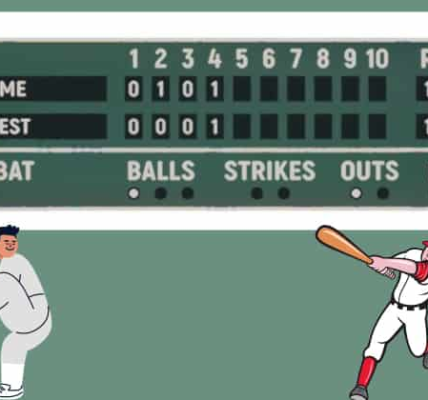In the realm of baseball, the acronym WAR represents Wins Above Replacement. This metric provides a thorough assessment of a player’s overall impact on their team, gauging the number of additional wins a player contributes in comparison to a replacement-level player in the same position.
When delving into the world of baseball statistics and player evaluations, understanding how to calculate WAR becomes essential. Meanwhile, it’s equally important to explore the concept of what a pennant represents in the world of baseball.
KEY POINTS
- “Wins Above Replacement” (WAR) is a metric in baseball that measures a player’s overall contribution by comparing their performance to that of a typical replacement-level player. It encompasses a range of skills including hitting, fielding, and pitching;
- The calculation of WAR is intricate, differing for position players and pitchers. It integrates multiple elements and adjustments like batting runs, defensive skills, and adjustments for league differences;
- WAR scores vary widely, starting from 0-1 for reserve players, rising to over 6 for elite players. This scale offers a way to gauge a player’s impact on their team’s success;
- Notable figures in the history of WAR include Barry Bonds and Babe Ruth, with Ruth holding the record for the highest WAR in a single season;
- Coaches, analysts, and players utilize WAR for various strategic decisions, including lineup creation, roster management, tracking player performance, and comparing players.
What is WAR in Baseball?
WAR, or Wins Above Replacement, is an advanced metric used to evaluate the overall impact of a baseball player on their team’s performance. It estimates the difference in wins a team would have if the player were substituted by a typical minor leaguer or bench player, termed a “replacement-level player.” This metric includes contributions in various areas such as hitting, base running, fielding, and pitching for pitchers, providing a holistic measure of a player’s worth compared to a baseline replacement.
Typically, WAR values range from 0 to 6, but these are not absolute limits. A negative WAR indicates performance below that of a replacement-level player, while exceptional players often exceed a WAR of 6 within a season. Calculating a player’s WAR involves aggregating numerous stats, including fielding, base running, hitting, and runs contributed or prevented. The player’s position and league context are also factored into this complex calculation, offering a nuanced view of their overall contribution to the team.
WAR Calculation

Calculating WAR (Wins Above Replacement), a crucial metric in baseball analytics, involves a multifaceted process with variations depending on the source. Notably, different entities like FanGraphs and Baseball-Reference offer their unique versions, fWAR and bWAR respectively, each with distinct methodologies.
This metric isn’t encapsulated by a singular formula but rather a series of intricate steps and components. The following is a broad outline of how WAR is computed for both position players and pitchers, highlighting its complexity:
For Position Players:
- Batting Runs: Evaluates offensive contributions through metrics such as home runs, hits, and walks;
- Base Running Runs: Gauges a player’s effectiveness on the bases, including aspects like stolen bases and running decisions;
- Fielding Runs: Assesses defensive skills, considering elements like range, arm strength, and error rates;
- Positional Adjustment: Accounts for the varying demands and importance of different field positions;
- Replacement Level: Establishes a baseline value using the performance of readily available players in similar positions;
- League Adjustment: Adjusts for disparities between leagues (like the American and National Leagues) and different playing eras;
- Combining Factors: Aggregates the above elements to calculate the total runs contributed above a replacement-level player;
- Converting Runs to Wins: Translates the aggregated runs into wins, using a conversion rate that typically hovers around 9-10 runs per win, adjusted for league and season specifics.
The computation of WAR is generally facilitated by advanced statistical software due to its complexity and the need for precision. While this overview covers the primary components, variations and additional factors might be included in different versions of the WAR calculation. This illustrates the depth and versatility of WAR as a metric for player evaluation in baseball.
WAR Calculation for Pitchers
Calculating WAR (Wins Above Replacement) for pitchers, while conceptually similar to position players, emphasizes distinct aspects of pitching performance. The process includes several specific steps tailored to evaluate a pitcher’s effectiveness:
- Starting with FIP or ERA: Depending on the specific WAR model used, either Fielding Independent Pitching (FIP) or Earned Run Average (ERA) serves as the foundation. FIP concentrates on elements within the pitcher’s control like strikeouts, walks, and home runs, while ERA reflects the average number of earned runs given up per nine innings;
- Park Factor Adjustments: Recognizing that certain ballparks may favor hitters or pitchers, adjustments are made to the pitcher’s statistics to account for the idiosyncrasies of different playing environments;
- Defense Adjustments: Given the interdependence between pitchers and fielders, the calculation modifies statistics to better represent the pitcher’s individual contribution, separating it from the influence of team defense;
- Replacement Level and League Adjustments: Similar to position players, the WAR for pitchers is adjusted for the level of a replacement player and factors specific to their league, ensuring a fair comparison across different settings;
- Conversion to Wins: The final step involves translating the pitcher’s runs above replacement into wins. This is typically done using a conversion rate that equates a certain number of runs to one win, adjusted for the specific context of the league and season.
These steps collectively contribute to a nuanced assessment of a pitcher’s value, distinguishing WAR as a sophisticated and comprehensive metric in baseball analytics.
WAR Ratings in Baseball
WAR (Wins Above Replacement) offers a valuable framework for gauging player performance in baseball. Its interpretation, however, may slightly vary based on the specific calculation method and source. Here’s a general scale for understanding WAR ratings:
| WAR Range | Description |
|---|---|
| 0-1 | Typically aligns with replacement-level or bench players. Their contribution is modest, generally not surpassing what might be expected from a minor league player. |
| 1-2 | Represents solid role players or platoon participants. These players add value but are usually not considered standout stars. |
| 2-3 | Indicates an average starter, contributing consistently and proving beneficial to their team. |
| 3-4 | Denotes above-average starters, often pivotal to their team’s success. |
| 4-5 | Correlates with All-Star caliber players, signifying some of the league’s top talent and crucial to team triumphs. |
| 5-6 | Highlights star players, ranking among the league’s best in their respective positions. |
| 6+ | Reflects superstar status, with players in this bracket often featuring in MVP discussions due to their elite performance. |
It’s important to remember that these are general guidelines; values can differ based on factors like calculation methods, league contexts, and playing eras. Also, since WAR accumulates over a season, a full season’s evaluation offers a more comprehensive view of a player’s value. However, while WAR is insightful, it should ideally be considered alongside other stats and qualitative evaluations, especially when comparing players across different positions.
The Effectiveness of WAR as a Baseball Statistic
Many statisticians advocate for WAR (Wins Above Replacement) as an exceptionally effective statistic for player evaluation in baseball. WAR stands out for its comprehensive approach, integrating various individual statistics to provide a broader, more holistic view of a player’s impact on their team.
The strength of WAR lies in its ability to contextualize player performances, offering insights not just into what a player does, but the significance of their actions within the team’s framework. While the process of calculating WAR can be complex, the insights gained from this completed statistic are substantial, revealing much about a player’s overall contribution to their team, both positively and negatively.
The Player with the Greatest Career WAR in Baseball History
Determining the baseball player with the highest career WAR (Wins Above Replacement) is not straightforward. Barry Bonds currently leads among position players with a remarkable career WAR of 162.8, marginally surpassing Babe Ruth’s 162.7. However, this comparison does not account for Ruth’s achievements as a pitcher. When considering Ruth’s pitching contributions, he ascends to the pinnacle of the all-time WAR rankings with an astounding 183.1. Following him is another pitcher, Walter Johnson, who amassed a WAR of 164.8. In this broader context, Bonds falls to the fourth position in the overall rankings.
The Record-Holders for the Highest Single-Season WAR

The record for the highest WAR (Wins Above Replacement) achieved in a single season is a testament to baseball’s rich history. Dominating this category is the legendary Babe Ruth, who holds not just the top spot but also the second and third places for single-season WAR among position players. His remarkable performance in 1923, at the age of 28, led to an unprecedented 14.2 WAR. In the modern era, Barry Bonds made a significant mark by registering an 11.9 WAR in 2001, earning him the sixth position on the all-time list. These achievements highlight the extraordinary talents and impacts these players had during their peak seasons.
The Significance of Career WAR in Baseball
Career WAR, or Wins Above Replacement, is an integral statistic in baseball that encapsulates a player’s overall contribution throughout their career. It quantifies the total number of additional wins a player has provided to their team compared to a replacement-level player. This metric is particularly useful for evaluating a player’s consistency and long-term impact on the game. By contrasting individual season performances with a player’s career WAR, one can discern whether certain seasons were exceptionally good or poor compared to their overall career. Additionally, as a player’s career progresses, their accumulated WAR offers a more comprehensive and insightful assessment of their skill and value to the team.
Conclusion
While calculating Wins Above Replacement (WAR) can be a complex task, the insights it provides are truly valuable. WAR serves as a valuable tool for making informed decisions regarding both your lineup and roster. This statistic proves to be an excellent measure of a player’s performance and is equally useful for making comparisons. If you’re a player, WAR is an invaluable statistic for tracking your personal progress on the field.




